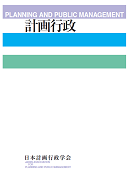Volume 35, Issue 4
Displaying 1-12 of 12 articles from this issue
- |<
- <
- 1
- >
- >|
Planning Administration on Energy Security
Introductory Remark
-
2012Volume 35Issue 4 Pages 1-2
Published: November 15, 2012
Released on J-STAGE: April 18, 2022
Download PDF (185K)
Special Articles
-
2012Volume 35Issue 4 Pages 3-8
Published: November 15, 2012
Released on J-STAGE: April 18, 2022
Download PDF (2706K) -
2012Volume 35Issue 4 Pages 9-14
Published: November 15, 2012
Released on J-STAGE: April 18, 2022
Download PDF (951K) -
2012Volume 35Issue 4 Pages 15-20
Published: November 15, 2012
Released on J-STAGE: April 18, 2022
Download PDF (376K) -
2012Volume 35Issue 4 Pages 21-26
Published: November 15, 2012
Released on J-STAGE: April 18, 2022
Download PDF (1166K) -
2012Volume 35Issue 4 Pages 27-32
Published: November 15, 2012
Released on J-STAGE: April 18, 2022
Download PDF (733K)
Research Paper
-
2012Volume 35Issue 4 Pages 33-44
Published: November 15, 2012
Released on J-STAGE: April 18, 2022
Download PDF (1836K) -
2012Volume 35Issue 4 Pages 45-55
Published: November 15, 2012
Released on J-STAGE: April 18, 2022
Download PDF (2749K) -
2012Volume 35Issue 4 Pages 56-61
Published: November 15, 2012
Released on J-STAGE: April 18, 2022
Download PDF (1233K)
Local and Regional Planning
-
2012Volume 35Issue 4 Pages 62-65
Published: November 15, 2012
Released on J-STAGE: April 18, 2022
Download PDF (1405K) -
2012Volume 35Issue 4 Pages 66-69
Published: November 15, 2012
Released on J-STAGE: April 18, 2022
Download PDF (927K)
Book Review
-
2012Volume 35Issue 4 Pages 70
Published: November 15, 2012
Released on J-STAGE: April 18, 2022
Download PDF (173K)
- |<
- <
- 1
- >
- >|
